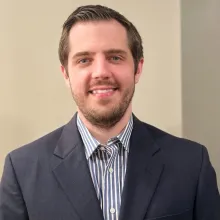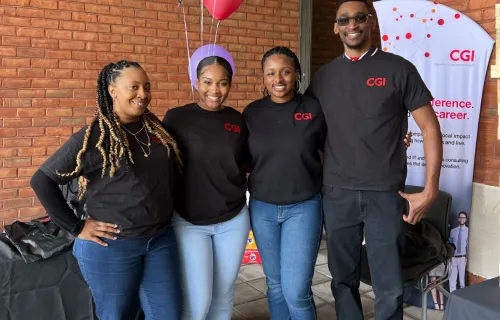My first career was as a classroom teacher, and I am now about two years in as a scrum master at CGI. The teams I support are developing automated tools that use machine learning to help their end customers with troubleshooting and answering common questions. My role is to enable the team to follow agile principles to incrementally deliver value and continuously improve their system.
I want to share my story with people who want to switch to a technical career but aren’t sure where to start. I’ve found the career change to be incredibly rewarding and that many of my existing skills transferred to my new role. CGI’s collaborative and supportive culture empowered me to get the training I needed, surrounded by a community of people who wanted me to succeed.
The path to consulting
When I headed to college, I really didn’t know what I wanted to do. Did I want to be a doctor? An environmental scientist? I ended up with a degree in Russian language and culture, of all things. Upon graduation, I earned my Master’s in Elementary Education, which led to a six-year career as a classroom teacher.
I enjoyed classroom teaching, and I made good relationships with fellow staff members and students. Along the way, I also started a tutoring company on the side. After several years, I started to feel like it was time for something new and that I wanted to learn and use different skill sets.
So, I asked myself: which of my skills could I build on to do something different? In a way, when you’re a teacher, the students and their parents are your clients. You interact with and report to external parties—parents as well as school administration. That’s what led me to consider consulting.
I knew someone who worked for CGI who had told me it was a supportive environment with an inclusive culture. I knew CGI viewed its employees as members and had a lot of programs in place to help people succeed and grow.
Joining CGI
When I joined CGI, I was apprehensive because it was a new industry for me, and I knew it would require new skill sets. I was confident in my soft skills, like working with people and written and oral communication, but it was my first time working in the tech industry. Thankfully, I learned first-hand about the variety of support that’s provided to help me succeed.
My member manager, Kay Goodman, made me feel comfortable asking about what I didn’t know and provided direction for me to learn the ropes. I was also assigned a “buddy”, Jacki Flynn, who I could go to with any questions as I navigated a new company and industry. Jacki had 10 years of experience in consulting, so she really became more of a mentor in helping me get started.
Helping hands
Truthfully, I found a helping hand everywhere I looked at CGI. I felt valued as I found a community of people who were willing to answer my questions and give advice on how to learn what I needed to be successful at my job. I found that through the relationships with people at CGI, people who are open and truly care about my development, I was able to enhance my skill set and perform well in a new job.
For example, I’m part of a “Business Agility Sync” community that brings together agile experts and innovators from across the company to share knowledge and answer questions. Many of the members have invaluable expertise, and they’re always willing to help. Once a month, members present on a topic, which often leads to follow-up conversations in our Microsoft Teams channel. The availability of information is incredible. And even though these are experts who are undoubtedly busy with their work, questions are always answered with genuine enthusiasm.
I’ve also had access to training to equip me with the foundation to succeed. CGI has on-demand online training, but also live training sessions with subject matter experts. Since joining, I’ve earned two agile certifications through live virtual training: Leading SAFe® and SAFe Advanced Scrum Master. Learning the critical skill for my job in a live, collaborative classroom environment gave me a great start in my new role.
As the first-ever Scaled Agile Global Transformation Partner, CGI has extensive experience providing transformational consulting, coaching and learning programs to help enterprises and organizations implement the Scaled Agile Framework® (SAFe®) and lean agile DevOps methods.
Transferable skills
When I look back now, I can clearly see the skills that transferred from classroom teacher to scrum master. For one: planning. Part of being a scrum master is program increment planning—creating a plan for the right amount of work to be completed in a set amount of time and keeping the team on track to meet targets. Not so different from creating annual and daily lesson plans to keep students moving toward their educational targets.
Another skill is anticipating roadblocks. Scrum masters need to be on the lookout for what could get in the way or slow things down—to either remove blockers or adjust the plan to account for them. The same can be said for teaching. For example, if a student struggles with adding one-digit numbers, you need to account for that in your plan to teach two-digit numbers to the class. In both cases, the skill is focusing your attention on the right place to ensure things stay on track.
Looking ahead
As I approach my two-year anniversary at CGI, I’m looking ahead to more career development. I am building client relationships and learning more about what CGI delivers. My member manager has guided me to think more consultatively and build trust with the client. I like gaining an understanding of what the client is trying to achieve and can see myself contributing more strategically in the future. I may pursue the release train engineer path—another agile certificate available through CGI’s virtual live training.
For now, I’m enjoying being a scrum master. I like helping the teams I support to become more mature in their agile delivery, and I’m driven to help them optimize processes and achieve those metrics that make the entire team feel successful.
If you’re looking to switch careers, my advice is to study job descriptions for the roles that interest you. Look for entry-level roles to get your foot in the door. Brainstorm a list of skills you’ve acquired, then find the overlap with the required skills listed in the job descriptions. Where you can, use the words from the job description in your resume. Also, make sure to check out reviews and try to meet people who work for the companies you’re looking at—a supportive environment can make all the difference.
Read more CGI member stories in the Life at CGI blog series.
Want to join us? Find your next opportunity at CGI Careers or join our talent network.







